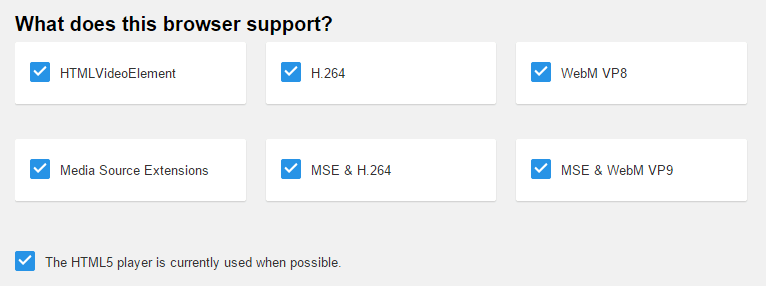
Over the last four years, YouTube have worked with browser vendors and the broader community to close those gaps, and now, YouTube uses HTML5 <video> by default in Chrome, IE 11, Safari 8 and in beta versions of Firefox.
The benefits of HTML5 extend beyond web browsers, and it's now also used in smart TVs and other streaming devices. Here are a few key technologies that have enabled this critical step forward:
By switching to HTML5, YouTube can now also make wider use of Google’s VP9 codec.
YouTube says this switch allows videos to start 15 to 80 percent faster and reduces the average bandwidth needed to stream a video by 35 percent. That may not seem like a big deal right now, but once you start streaming 4k video, that 35 percent reduction could be the difference between enjoying the video or staring at the “buffering” screen. YouTube started streaming VP9 videos in 2013 and has since served “hundreds of billions of VP9 videos.”
Now that HTML5 video is the default on YouTube, Google is deprecating its old-style <object> Flash embeds and its Flash API. YouTube recommends you only use its <iframe> embeds to embed videos going forward because that allows it to use whatever technology your visitors’ browsers support.
HTML5 video player uses a Media Source Extension feature called adaptive bitrate which adjust video quality on the fly depending on network conditions, reduced buffering by more than 50 percent globally and as much as 80 percent on heavily-congested networks.

Finally, Google is using other fancy technologies like Fullscreen APIs for immersive fullscreen viewing experience with a standard HTML interface, as well as Encrypted Media Extensions and Common Encryption for supporting multiple content protection technologies on different platforms with a single set of
assets.
Web Real-Time Communication (WebRTC), an open project for real-time voice and video communication, allows YouTube’s HTML5 video player to provide broadcasting tools from within the browser, no plugins required.
Fullscreen
Using the new fullscreen APIs in HTML5, YouTube is able to provide an immersive fullscreen viewing experience (perfect for those 4K videos), all with standard HTML UI.
These advancements have benefitted not just YouTube’s community, but the entire industry. Other content providers like Netflix and Vimeo, as well as companies like Microsoft and Apple have embraced HTML5 and been key contributors to its success. By providing an open standard platform, HTML5 has also enabled new classes of devices like Chromebooks and Chromecast. You can support HTML5 by using the <iframe> API everywhere you embed YouTube videos on the web.
Source:
Source: YouTube

No comments:
Post a Comment